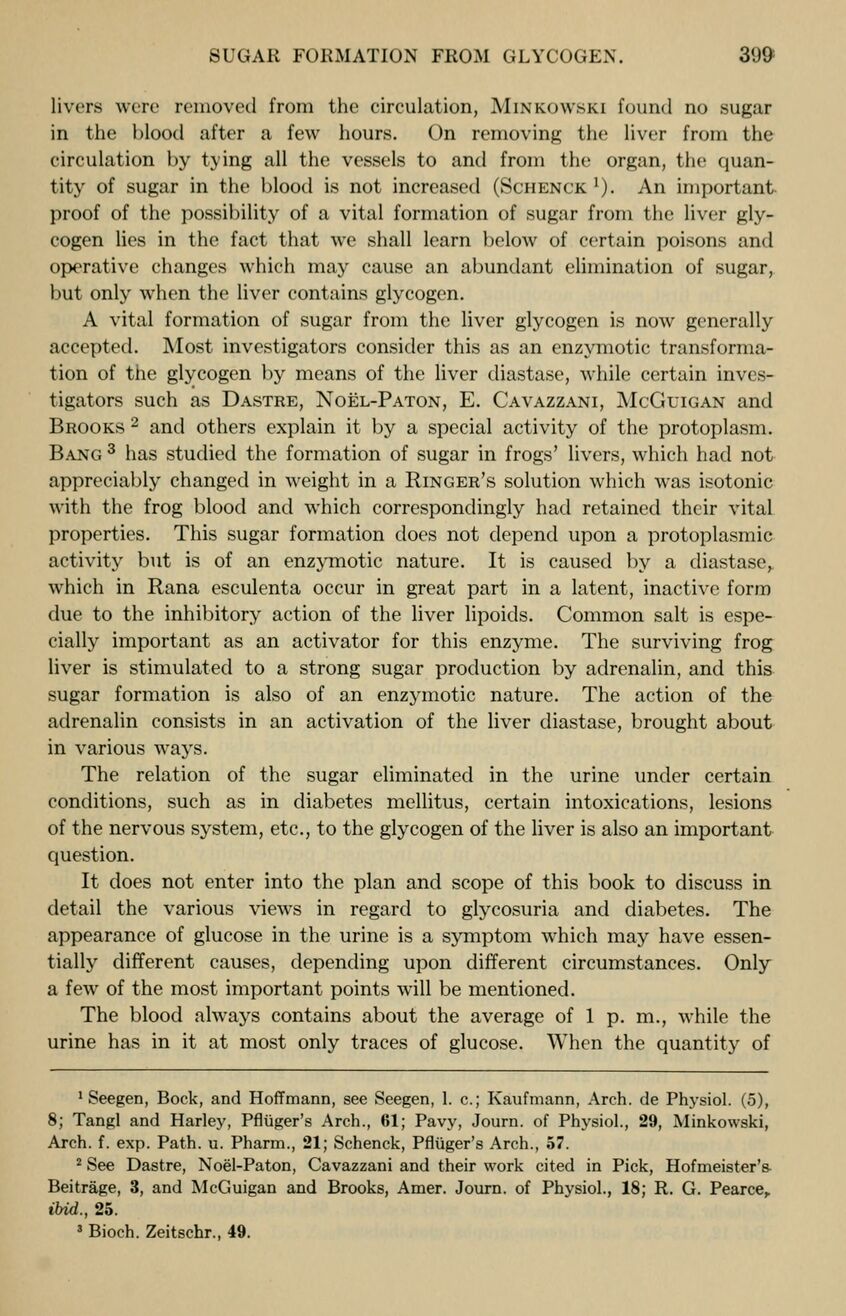
Full resolution (JPEG) - On this page / på denna sida - VII. The Liver - Glycogen and its Formation

<< prev. page << föreg. sida << >> nästa sida >> next page >>
Below is the raw OCR text
from the above scanned image.
Do you see an error? Proofread the page now!
Här nedan syns maskintolkade texten från faksimilbilden ovan.
Ser du något fel? Korrekturläs sidan nu!
This page has never been proofread. / Denna sida har aldrig korrekturlästs.
SUGAR FORMATION FROM GLYCOGEN. 39$
livers wire removed from the circulation, Minkowski found no sugar
in the blood after a few hours. On removing the liver from the
circulation by tying all the vessels to and from the organ, the quan-
tity of sugar in the blood is not increased (Schenck 1
). An important
proof of the possibility of a vital formation of sugar from the liver gly-
cogen lies in the fact that we shall learn below of certain poisons and
operative changes which may cause an abundant elimination of sugar,
but only when the liver contains glycogen.
A vital formation of sugar from the liver glycogen is now generally
accepted. Most investigators consider this as an enzymotic transforma-
tion of the glycogen by means of the liver diastase, while certain inves-
tigators such as Dastre, Noel-Paton, E. Cavazzani, McGuigan and
Brooks 2
and others explain it by a special activity of the protoplasm.
Bang 3 has studied the formation of sugar in frogs’ livers, which had not
appreciably changed in weight in a Ringer’s solution which was isotonic
with the frog blood and which correspondingly had retained their vital
properties. This sugar formation does not depend upon a protoplasmic
activity but is of an enzymotic nature. It is caused by a diastase^
which in Rana esculenta occur in great part in a latent, inactive form
due to the inhibitory action of the liver lipoids. Common salt is espe-
cially important as an activator for this enzyme. The surviving frog
liver is stimulated to a strong sugar production by adrenalin, and this
sugar formation is also of an enzymotic nature. The action of the
adrenalin consists in an activation of the liver diastase, brought about
in various ways.
The relation of the sugar eliminated in the urine under certain
conditions, such as in diabetes mellitus, certain intoxications, lesions
of the nervous system, etc., to the glycogen of the liver is also an important
question.
It does not enter into the plan and scope of this book to discuss in
detail the various views in regard to glycosuria and diabetes. The
appearance of glucose in the urine is a symptom which may have essen-
tially different causes, depending upon different circumstances. Only
a few of the most important points will be mentioned.
The blood always contains about the average of 1 p. m., while the
urine has in it at most only traces of glucose. When the quantity of
’Seegen, Bock, and Hoffmann, see Seegen, 1. c; Kaufmann, Arch, de Physiol. (5),
8; Tangl and Harley, Pfluger’s Arch., 61; Pavy, Journ. of Physiol., 29, Minkowski,
Arch. f. exp. Path. u. Pharm., 21; Schenck, Pfluger’s Arch., 57.
2
See Dastre, Noel-Paton, Cavazzani and their work cited in Pick, Hofmeister’s-
Beitrage, 3, and McGuigan and Brooks, Amer. Journ. of Physiol., 18; R. G. Pearce,.
ibid., 25.
8
Bioch. Zeitschr., 49.
<< prev. page << föreg. sida << >> nästa sida >> next page >>